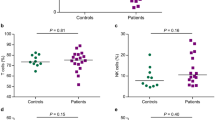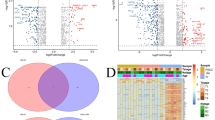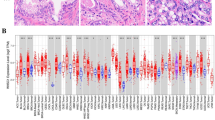Abstract
Penile squamous cell carcinoma (PSCC) with a poor prognosis lacks reliable biomarkers for stratifying patients. Fas-associated death domain (FADD) could regulate cell proliferation and has shown promising diagnostic and prognostic significance in multiple cancers. However, researchers have not determined how FADD exerts its effect on PSCC. In this study, we set out to investigate the clinical features of FADD and the prognostic impact of PSCC. Additionally, we also assessed the role of affecting the immune environment in PSCC. Immunohistochemistry was carried out to evaluate the protein expression of FADD. The difference between FADDhigh and FADDlow was explored by RNA sequencing from available cases. The immune environment evaluation of CD4, CD8, and Foxp3 was performed by immunohistochemical. In this study, we found that FADD was overexpressed in 19.6 (39/199) patients, and the overexpression of FADD was associated with phimosis (p=0.007), N stage (p<0.001), clinical stage (p=0.001), and histologic grade (p=0.005). The overexpression of FADD was an independent prognostic factor for both PFS (HR 3.976, 95% CI 2.413–6.553, p<0.001) and OS (HR 4.134, 95% CI 2.358–7.247, p<0.001). In addition, overexpression of FADD was mainly linked to T cell activation and PD-L1 expression combined with PD-L1 checkpoint in cancer. Further validation demonstrated that overexpression of FADD was positively correlated with the infiltration of Foxp3 in PSCC (p=0.0142). It is the first time to show that overexpression of FADD is an adjunct biomarker with poor prognosis in PSCC and could also serve as a tumor immune environment regulator.



Similar content being viewed by others
Data availability
The datasets generated during and/or analyzed during the current study are available from the corresponding author upon reasonable request.
References
Clark PE, Spiess PE, Agarwal N, Biagioli MC, Ho M (2013) Penile cancer: Clinical Practice Guidelines in Oncology Journal of the National Comprehensive Cancer Network: JNCCN 11:594-615.
Siegel RL, Miller KD, Fuchs HE, Jemal A (2021) Cancer Statistics, 2021. CA Cancer J Clin 71:7–33. https://doi.org/10.3322/caac.21654
Horenblas S (2001) Lymphadenectomy for squamous cell carcinoma of the penis. Part 2: The role and technique of lymph node dissection BJU. International 88:473–483
Graafland NM, Moonen LM, van Boven HH, van Werkhoven E, Kerst JM, Horenblas S (2011) Inguinal recurrence following therapeutic lymphadenectomy for node positive penile carcinoma: outcome and implications for management. J Urol 185:888–893. https://doi.org/10.1016/j.juro.2010.10.059
Pandey D, Mahajan V, Kannan RR (2006) Prognostic factors in node-positive carcinoma of the penis. J Surg Oncol 93:133–138. https://doi.org/10.1002/jso.20414
Xiao R, Allen CT, Tran L, Patel P, Park SJ, Chen Z, Van Waes C, Schmitt NC (2018) Antagonist of cIAP1/2 and XIAP enhances anti-tumor immunity when combined with radiation and PD-1 blockade in a syngeneic model of head and neck cancer. Oncoimmunology 7:e1471440. https://doi.org/10.1080/2162402X.2018.1471440
Choi EJ, Yun JA, Jabeen S, Jeon EK, Won HS, Ko YH, Kim SY (2014) Prognostic significance of TMEM16A, PPFIA1, and FADD expression in invasive ductal carcinoma of the breast World. J Surg Oncol 12:137. https://doi.org/10.1186/1477-7819-12-137
Brown LA, Kalloger SE, Miller MA, Shih Ie M, McKinney SE, Santos JL, Swenerton K, Spellman PT, Gray J, Gilks CB, Huntsman DG (2008) Amplification of 11q13 in ovarian carcinoma. Genes Chromosom Cancer 47:481–489. https://doi.org/10.1002/gcc.20549
van Rossum AG, van Bragt MP, Schuuring-Scholtes E, van der Ploeg JC, van Krieken JH, Kluin PM, Schuuring E (2006) Transgenic mice with mammary gland targeted expression of human cortactin do not develop (pre-malignant) breast tumors: studies in MMTV-cortactin and MMTV-cortactin/-cyclin D1 bitransgenic mice BMC. Cancer 6:58. https://doi.org/10.1186/1471-2407-6-58
Chinnaiyan AM, O’Rourke K, Tewari M, Dixit VM (1995) FADD, a novel death domain-containing protein, interacts with the death domain of Fas and initiates apoptosis. Cell 81:505–512. https://doi.org/10.1016/0092-8674(95)90071-3
Strasser A, Jost PJ, Nagata S (2009) The many roles of FAS receptor signaling in the immune system. Immunity 30:180–192. https://doi.org/10.1016/j.immuni.2009.01.001
Mizushima N, Komatsu M (2011) Autophagy: renovation of cells and tissues Cell 147:728-741. https://doi.org/10.1016/j.cell.2011.10.026
Pyo JO, Jang MH, Kwon YK, Lee HJ, Jun JI, Woo HN, Cho DH, Choi B, Lee H, Kim JH, Mizushima N, Oshumi Y, Jung YK (2005) Essential roles of Atg5 and FADD in autophagic cell death: dissection of autophagic cell death into vacuole formation and cell death. J Biol Chem 280:20722–20729. https://doi.org/10.1074/jbc.M413934200
Baginska J, Viry E, Berchem G, Poli A, Noman MZ, van Moer K, Medves S, Zimmer J, Oudin A, Niclou SP, Bleackley RC, Goping IS, Chouaib S, Janji B (2013) Granzyme B degradation by autophagy decreases tumor cell susceptibility to natural killer-mediated lysis under hypoxia Proceedings of the National Academy of Sciences of the United States of America 110:17450-17455. https://doi.org/10.1073/pnas.1304790110
Noman MZ, Janji B, Kaminska B, Van Moer K, Pierson S, Przanowski P, Buart S, Berchem G, Romero P, Mami-Chouaib F, Chouaib S (2011) Blocking hypoxia-induced autophagy in tumors restores cytotoxic T-cell activity and promotes regression. Cancer Res 71:5976–5986. https://doi.org/10.1158/0008-5472.Can-11-1094
Mgrditchian T, Arakelian T, Paggetti J, Noman MZ, Viry E, Moussay E, Van Moer K, Kreis S, Guerin C, Buart S, Robert C, Borg C, Vielh P, Chouaib S, Berchem G, Janji B (2017) Targeting autophagy inhibits melanoma growth by enhancing NK cells infiltration in a CCL5-dependent manner Proceedings of the National Academy of Sciences of the United States of America 114:E9271-e9279. https://doi.org/10.1073/pnas.1703921114
Uhl M, Kepp O, Jusforgues-Saklani H, Vicencio JM, Kroemer G, Albert ML (2009) Autophagy within the antigen donor cell facilitates efficient antigen cross-priming of virus-specific CD8+ T cells Cell death and differentiation 16:991-1005. https://doi.org/10.1038/cdd.2009.8
Xu X, Araki K, Li S, Han JH, Ye L, Tan WG, Konieczny BT, Bruinsma MW, Martinez J, Pearce EL, Green DR, Jones DP, Virgin HW, Ahmed R (2014) Autophagy is essential for effector CD8(+) T cell survival and memory formation. Nat Immunol 15:1152–1161. https://doi.org/10.1038/ni.3025
Rouschop KM, van den Beucken T, Dubois L, Niessen H, Bussink J, Savelkouls K, Keulers T, Mujcic H, Landuyt W, Voncken JW, Lambin P, van der Kogel AJ, Koritzinsky M, Wouters BG (2010) The unfolded protein response protects human tumor cells during hypoxia through regulation of the autophagy genes MAP1LC3B and ATG5. J Clin Invest 120:127–141. https://doi.org/10.1172/JCI40027
Guo H, Chitiprolu M, Roncevic L, Javalet C, Hemming FJ, Trung MT, Meng L, Latreille E, Tanese de Souza C, McCulloch D, Baldwin RM, Auer R, Cote J, Russell RC, Sadoul R, Gibbings D (2017) Atg5 Disassociates the V1V0-ATPase to Promote Exosome Production and Tumor Metastasis Independent of Canonical Macroautophagy Dev Cell 43:716-730 e717. https://doi.org/10.1016/j.devcel.2017.11.018
Gonzalez-Moles MA, Ayen A, Gonzalez-Ruiz I, de Porras-Carrique T, Gonzalez-Ruiz L, Ruiz-Avila I, Ramos-Garcia P (2020) Prognostic and Clinicopathological Significance of FADD Upregulation in Head and Neck Squamous Cell Carcinoma: A Systematic Review and Meta-Analysis Cancers (Basel) 12. https://doi.org/10.3390/cancers12092393
Chien HT, Cheng SD, Chuang WY, Liao CT, Wang HM, Huang SF (2016) Clinical Implications of FADD Gene Amplification and Protein Overexpression in Taiwanese Oral Cavity Squamous Cell Carcinomas. PLoS One 11:e0164870. https://doi.org/10.1371/journal.pone.0164870
Gibcus JH, Menkema L, Mastik MF, Hermsen MA, de Bock GH, van Velthuysen ML, Takes RP, Kok K, Alvarez Marcos CA, van der Laan BF, van den Brekel MW, Langendijk JA, Kluin PM, van der Wal JE, Schuuring E (2007) Amplicon mapping and expression profiling identify the Fas-associated death domain gene as a new driver in the 11q13.3 amplicon in laryngeal/pharyngeal cancer. Clin Cancer Res 13:6257–6266. https://doi.org/10.1158/1078-0432.CCR-07-1247
Peng QH, Wang CH, Chen HM, Zhang RX, Pan ZZ, Lu ZH, Wang GY, Yue X, Huang W, Liu RY (2021) CMTM6 and PD-L1 coexpression is associated with an active immune microenvironment and a favorable prognosis in colorectal cancer. J Immunother Cancer 9. https://doi.org/10.1136/jitc-2020-001638
Zhou QH, Han H, Lu JB, Liu TY, Huang KB, Deng CZ, Li ZS, Chen JP, Yao K, Qin ZK, Liu ZW, Li YH, Guo SJ, Ye YL, Zhou FJ, Liu RY (2020) Up-regulation of indoleamine 2,3-dioxygenase 1 (IDO1) expression and catalytic activity is associated with immunosuppression and poor prognosis in penile squamous cell carcinoma patients. Cancer Commun (Lond) 40:3–15. https://doi.org/10.1002/cac2.12001
Castaneda CA, Castillo M, Aliaga K, Bernabe LA, Casavilca S, Sanchez J, Torres-Cabala CA, Gomez HL, Mas L, Dunstan J, Cotrina JM, Abugattas J, Chavez I, Ruiz E, Montenegro P, Rojas V, Orrego E, Galvez-Nino M, Felix B, Landa-Baella MP, Vidaurre T, Villa MR, Zevallos R, Taxa L, Guerra H (2019) Level of tumor-infiltrating lymphocytes and density of infiltrating immune cells in different malignancies Biomarkers in medicine 13:1481-1491. https://doi.org/10.2217/bmm-2019-0178
Mouasni S, Tourneur L (2018) FADD at the Crossroads between Cancer and Inflammation. Trends Immunol 39:1036–1053. https://doi.org/10.1016/j.it.2018.10.005
Cimino Y, Costes A, Damotte D, Validire P, Mistou S, Cagnard N, Alifano M, Régnard JF, Chiocchia G, Sautès-Fridman C, Tourneur L (2012) FADD protein release mirrors the development and aggressiveness of human non-small cell lung cancer. Br J Cancer 106:1989–1996. https://doi.org/10.1038/bjc.2012.196
Tourneur L, Mistou S, Michiels FM, Devauchelle V, Renia L, Feunteun J, Chiocchia G (2003) Loss of FADD protein expression results in a biased Fas-signaling pathway and correlates with the development of tumoral status in thyroid follicular cells. Oncogene 22:2795–2804. https://doi.org/10.1038/sj.onc.1206399
Hartwig T, Montinaro A, von Karstedt S, Sevko A, Surinova S, Chakravarthy A, Taraborrelli L, Draber P, Lafont E, Arce Vargas F, El-Bahrawy MA, Quezada SA, Walczak H (2017) The TRAIL-Induced Cancer Secretome Promotes a Tumor-Supportive Immune Microenvironment via CCR2 Mol Cell 65:730-742 e735. https://doi.org/10.1016/j.molcel.2017.01.021
Ehlken H, Krishna-Subramanian S, Ochoa-Callejero L, Kondylis V, Nadi NE, Straub BK, Schirmacher P, Walczak H, Kollias G, Pasparakis M (2014) Death receptor-independent FADD signalling triggers hepatitis and hepatocellular carcinoma in mice with liver parenchymal cell-specific NEMO knockout. Cell Death Differ 21:1721–1732. https://doi.org/10.1038/cdd.2014.83
Bowman BM, Sebolt KA, Hoff BA, Boes JL, Daniels DL, Heist KA, Galbán CJ, Patel RM, Zhang J, Beer DG, Ross BD, Rehemtulla A, Galbán S (2015) Phosphorylation of FADD by the kinase CK1α promotes KRASG12D-induced lung cancer. Sci Signal 8:ra9. https://doi.org/10.1126/scisignal.2005607
Rasamny JJ, Allak A, Krook KA, Jo VY, Policarpio-Nicolas ML, Sumner HM, Moskaluk CA, Frierson HF, Jr., Jameson MJ (2012) Cyclin D1 and FADD as biomarkers in head and neck squamous cell carcinoma Otolaryngol Head Neck Surg 146:923-931. https://doi.org/10.1177/0194599811435052
González-Moles M, Ayén Á, González-Ruiz I, de Porras-Carrique T, González-Ruiz L, Ruiz-Ávila I, Ramos-García P (2020) Prognostic and Clinicopathological Significance of FADD Upregulation in Head and Neck Squamous Cell Carcinoma: A Systematic Review and Meta-Analysis Cancers 12. https://doi.org/10.3390/cancers12092393
Zhang J, Kabra NH, Cado D, Kang C, Winoto A (2001) FADD-deficient T cells exhibit a disaccord in regulation of the cell cycle machinery. J Biol Chem 276:29815–29818. https://doi.org/10.1074/jbc.M103838200
Chen G, Bhojani MS, Heaford AC, Chang DC, Laxman B, Thomas DG, Griffin LB, Yu J, Coppola JM, Giordano TJ, Lin L, Adams D, Orringer MB, Ross BD, Beer DG, Rehemtulla A (2005) Phosphorylated FADD induces NF-kappaB, perturbs cell cycle, and is associated with poor outcome in lung adenocarcinomas. Proc Natl Acad Sci U S A 102:12507–12512. https://doi.org/10.1073/pnas.0500397102
Hueber AO, Zörnig M, Bernard AM, Chautan M, Evan G (2000) A dominant negative Fas-associated death domain protein mutant inhibits proliferation and leads to impaired calcium mobilization in both T-cells and fibroblasts. J Biol Chem 275:10453–10462. https://doi.org/10.1074/jbc.275.14.10453
Newton K, Kurts C, Harris AW, Strasser A (2001) Effects of a dominant interfering mutant of FADD on signal transduction in activated T cells. Curr Biol 11:273–276. https://doi.org/10.1016/s0960-9822(01)00067-7
Acknowledgements
We thank Cheng-Chao Shen for his kind help in pathological assistance and sample collection.
Funding
This study was supported by the National Natural Science Foundation of China (No. 81772755) during the conduct of study.
Author information
Authors and Affiliations
Contributions
Study conception and design: R Yan, T Xue, and H Han; acquisition of data: R Yan, SJ Guo, ZS Li, Chong Wu, and Tingyu Liu; performed the experiments and analysis: X X, JJ Jin, LC Wei, LB Xiong, R Yan, and T Xue; analysis and interpretation of data: T Xue, LJ Jiang, and HL Ma; funding acquisition: H Han; drafting of the manuscript: R Yan, T Xue; collection and integration of data: critical revision of the manuscript for important intellectual content: FJ Zhou, K Yao, RY Liu, H Han; statistical analysis: R Yan, T Xue, and RY Liu; administrative, technical, or material support: RY Liu and H Han; supervision: RY Liu and H Han.
Corresponding authors
Ethics declarations
Ethics approval
The Institutional Review Board of Sun Yat-Sen University Cancer Center approved this study.
Conflict of interest
The authors declare no competing interests.
Additional information
Publisher’s note
Springer Nature remains neutral with regard to jurisdictional claims in published maps and institutional affiliations.
Supplementary Information

Figure S1.
The mRNA level of FADD in FADDlow and FADDhigh group. P values were calculated with the use of the Student’s t-test. (PNG 56 kb)

Figure S2.
Difference analysis of FADDlow and FADDhigh group DEGs in PSCC. a Volcano plot of DEGs between samples in PSCC with FADDlow and FADDhigh group; b Heatmap between FADDlow and FADDhigh group DEGs by clustering analysis. (PNG 2145 kb)

Figure S3.
Representative micrographs of the staining of Foxp3 (a), CD8+ (b) and CD4+ (c) T cells by immunohistochemistry assay. The upper image shows immunohistochemistry for FADD at low magnification (100×). A lower image in each image shows the high magnification in the upper ones (400×). (PNG 2658 kb)
Table S1
RIIN value of RNA samples used for RNA sequencing. (DOCX 17 kb)
Table S2
The DEGs of FADDlow and FADDhigh group. (XLS 42 kb)
Rights and permissions
Springer Nature or its licensor (e.g. a society or other partner) holds exclusive rights to this article under a publishing agreement with the author(s) or other rightsholder(s); author self-archiving of the accepted manuscript version of this article is solely governed by the terms of such publishing agreement and applicable law.
About this article
Cite this article
Xue, T., Yan, R., Li, Z. et al. Prognostic significance and immune correlates of FADD in penile squamous cell carcinoma. Virchows Arch 482, 869–878 (2023). https://doi.org/10.1007/s00428-023-03514-9
Received:
Revised:
Accepted:
Published:
Issue Date:
DOI: https://doi.org/10.1007/s00428-023-03514-9




